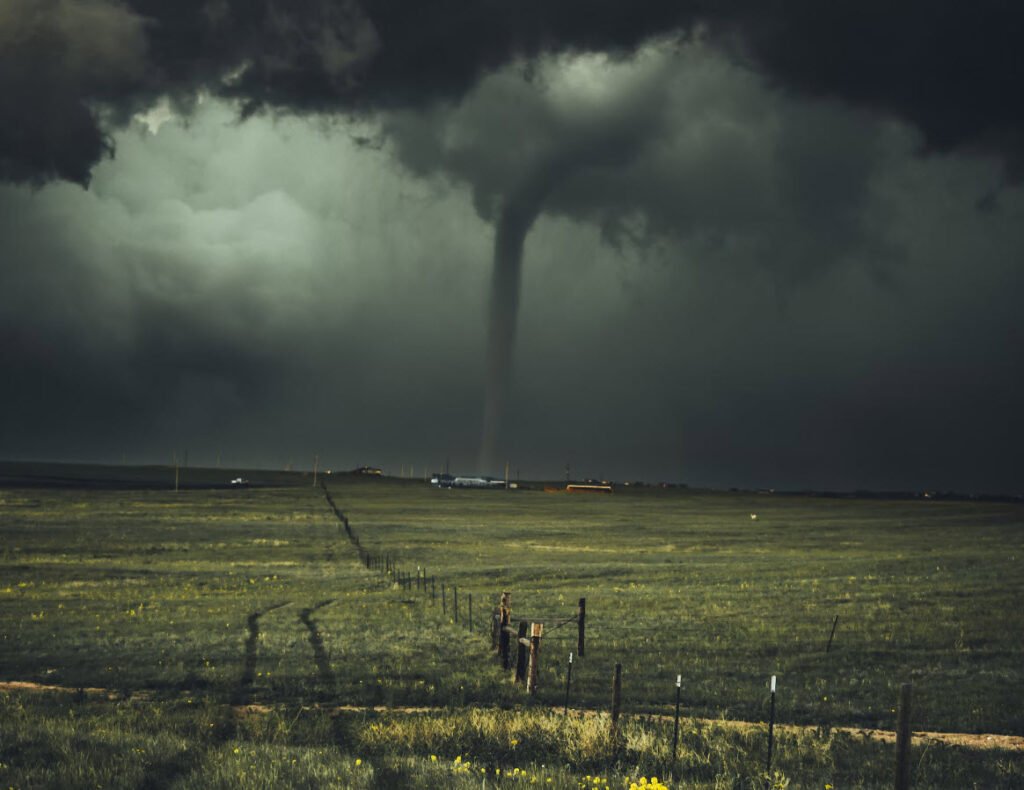
The term “weather” describes the localized atmospheric conditions, such as the temperature, humidity, air pressure, wind, and precipitation. Worldwide variations in weather patterns and conditions can have a substantial impact on people’s day-to-day activities, including transportation, agriculture, energy use, and outdoor activities.
Geographical location, atmospheric pressure patterns, and ocean currents are only a few of the many variables that can affect the weather. In order to comprehend the causes of weather and forecast future circumstances, meteorologists study the science of weather.
There are many types of weather that occur around the world. Here are some of the most common types of weather:
- Wind-Windy
- Tornado
- Rain-Rainy
- Cloud-Cloudy
- Snow-Snowy
- Cold
- Freezing
- Thunder
- Sleet-Sleeting
- Lightning
- Hail-Hailing
- Clear Sky
- Storm
- Warm
- Partly Cloudy
1) Wind-Windy
Wind refers to the movement of air, which can be caused by differences in air pressure. A windy day is when the wind speed is high, often accompanied by gusts that can be strong enough to cause physical discomfort or make it difficult to walk or carry objects. Wind can affect various aspects of daily life, such as transportation, energy production, and outdoor activities. Wind can also contribute to the spread of fire and dust storms.
Wind speed and direction are important factors for sailors, pilots, and wind energy producers. The strength and direction of wind can also impact weather patterns and climates.
2) Tornado
A tornado is an air column that is fast rotating and makes contact with both the Earth’s surface and a cloud. One of the most hazardous and devastating types of weather, tornadoes are sometimes known as “twisters.”
They develop during thunderstorms and have the potential to do a great deal of harm, such as crushing buildings, toppling trees, and hurling vehicles and other heavy objects. In particular parts of the planet, such as “Tornado Alley” in the United States’ Midwest and Great Plains, tornadoes frequently form. The effect of tornadoes can be lessened by early warning systems and good planning.
3) Rain-Rainy
Rainy weather is characterized by precipitation in the form of water droplets from clouds, causing wet conditions on the ground. It can range from light drizzles to heavy downpours. Some people enjoy the sound of rain, while others find it gloomy. Regardless, it’s important to stay safe and dry.
4) Cloud-Cloudy
A cloudy day is when the sky is covered with clouds, which can be thick or thin. Clouds are formed when water vapor condenses into water droplets or ice crystals, blocking the sun’s rays. Cloudy weather can range from partially sunny to overcast and can bring precipitation like rain or snow.
Cloud cover can affect temperature and visibility, creating a moody or cool atmosphere.
5) Snow-Snowy
Snowy weather occurs when snowflakes fall from clouds and accumulate on the ground. It’s caused by low temperatures and moisture in the air. Snow can range from light flurries to heavy blizzards and can create a beautiful winter wonderland. However, it can also lead to dangerous driving conditions and power outages.
It’s important to prepare for snowy weather and stay safe.
6) Cold
Cold weather refers to temperatures below the normal range for a particular area and time of year. It’s caused by low atmospheric pressure and can be accompanied by strong winds and precipitation like snow or sleet. Cold weather can be uncomfortable and even dangerous, leading to hypothermia and frostbite.
It’s important to stay warm by dressing in layers, covering exposed skin, and staying active.
7) Freezing
Freezing refers to the process of a liquid turning into a solid as its temperature drops below its freezing point. This occurs when the temperature is below 0°C (32°F) for water. Freezing can occur in nature, for example, when water turns into ice, or in industrial processes, such as when food is frozen for preservation.
Freezing can also refer to the weather, as in extremely cold conditions when the temperature drops below freezing.
8) Thunder
The fast expansion of air around a lightning bolt causes thunder, a loud, explosive sound. It is created when air is heated to tens of thousands of degrees, which causes it to rapidly expand and produce the thunder we hear. Thunder is a natural and significant component of the atmosphere, despite the fact that it can be frightful.
Thunderstorms can bring much-needed rain, but they can also harm people and property and be dangerous.
9) Sleet-Sleeting
Sleet is precipitation that forms when raindrops freeze into ice pellets before reaching the ground. It occurs when a layer of freezing air is above the ground and a layer of above-freezing air is above the precipitation. Sleet produces a pinging or rattling sound as it hits surfaces, and can make travel difficult due to slippery conditions.
It’s important to take precautions during sleet storms, such as slowing down when driving and dressing warmly when outside.
10) Lightning
Lightning is a bright electrical discharge that occurs in the atmosphere, usually during a thunderstorm. It’s caused by the buildup and discharge of electrical energy between charged particles in the atmosphere. Lightning can strike the ground, objects, or other parts of the atmosphere, and can be incredibly bright and intense.
While lightning is beautiful, it can also be very dangerous and cause fires, damage, and injury. It’s important to take precautions during thunderstorms to stay safe.
11) Hail-Hailing
Hail is a type of precipitation that appears as ice pellets or small balls and falls from the sky during thunderstorms. It develops as water droplets within a thunderstorm are propelled up and down by powerful currents, freezing, and enlarging as they move.
Hailstones can be as small as pea-sized hail or as big and damaging as golf balls or even bigger. Hail can harm buildings, automobiles, and crops while posing a threat to anyone caught in the storm.
12) Clear Sky
A clear sky refers to a weather situation when there are either no clouds at all or very few clouds in the sky. A clear, sunny, and bright view of the sky is the result of this. Clear skies make for warmer weather that is perfect for outdoor pursuits like hiking, picnics, and gardening.
However, it can also lead to a high UV index and a higher risk of sunburn, thus wearing enough sunscreen is essential.
13) Storm
A storm is a meteorological phenomenon characterized by strong winds, heavy precipitation (such as rain, snow, hail, sleet), thunder and lightning, and sometimes tornadoes. Storms can cause significant damage to property and disrupt transportation and power systems.
It is important to stay informed about severe weather conditions and to take appropriate safety measures, such as seeking shelter indoors and avoiding travel during a storm.
14) Warm
Warm refers to an above-average or pleasant temperature, especially in relation to its surroundings. It usually feels good to be warm, and warm weather is often associated with sunny summer days. On the other side, prolonged warm spells can generate deadly heatwaves that can result in illnesses related to the heat.
To keep safe during hot weather, it’s crucial to drink enough of water, restrict your outside activities during the warmest parts of the day, and take pauses in places with air conditioning.
15) Partly Cloudy
The term “partly cloudy weather” describes a situation where the sky is both partially clouded over and partially clear. The sun may be partially hidden by clouds on partly cloudy days, yet enough sunlight still reaches the earth to produce some warmth.
Throughout the day, the amount of clouds can change, with some periods being clearer and others being cloudier. When it’s partly cloudy outside, you may still enjoy a comfortable, warm environment while still getting some sun protection.
You may also read:
- Nourishing Passion – Specific Foods to Promote Sexual Health
- The Power of Compound Exercises – 5 Essential Moves for Full-Body Strength
- Alteryx Text Mining
- Exploring the Delightful World of Cold Sauces – From Aioli to Tapenade
- 11 Powerful Poses to Help You Shed Pounds
- How To Prepare Keto Vanilla Cake
- 15 Different Types of Citrus Fruits You Need To Know
- A Guide to the Diverse World of Peppers
- Exploring the World of White Teas – A Delicate Symphony of Flavors
- Crafting a Vienna Vanilla Coffee Latte
- 4 Easy Steps to Prepare the Perfect Macchiato
- Cold Water vs. Hot Water – A Comparison of Health Benefits
- Exploring the 12 Universal Laws – A Guide to Understanding Life and Reality
- 20 Snacks Under 100 Calories – All You Need To Know
- Sunset Smoothie For Weight Loss – Preparation and Benefits
- The 6-Day Total Body Workout Routine
- Essential Post-Workout Stretches for a Better Recovery
- Top 16 World’s Healthiest Foods
- Yoga Mudras and Their Positive Effects on Health
- 34 Medicinal Plants You Can Grow In Your Garden







